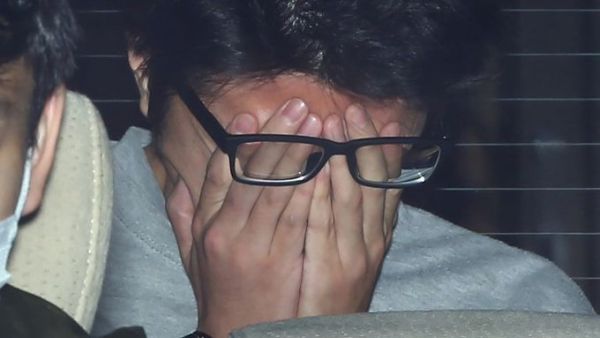A Japanese serial killer dubbed the 'Twitter killer' was sentenced to death by a Tokyo court today for murdering and dismembering nine people he met online.
Takahiro Shiraishi, 30, admitted killing and butchering eight women and one man, aged between 15 and 26, who he met on the social media platform.
He murdered nine people after luring them over Twitter. Now Japan has sentenced Takahiro Shiraishi to death. https://t.co/wfRYzpwdyk
— BBC Breaking News (@BBCBreaking) December 15, 2020
The female victims were also found to be have been sexually assaulted.
His lawyers had argued he should receive a prison sentence rather than the death penalty because his victims expressed suicidal thoughts on social media and so had consented to death.
But the death sentence was handed down to Shiraishi today after the court found him criminally responsible for their deaths.
'None of the nine victims consented to be killed, including silent consent,' Presiding Judge Naokuni Yano said, according to public broadcaster NHK.
'It is extremely grave that the lives of nine young people were taken away. The dignity of the victims was trampled upon.'
Yano described the murders as 'extremely vicious in crime history' and ruled Shiraishi was mentally fit to be held responsible for them.
The father of one 25-year-old victim said in court last month that he 'will never forgive Shiraishi even if he dies', NHK reported.
He said 'Even now, when I see a woman of my daughter's age, I mistake her for my daughter. This pain will never go away. Give her back to me.'
Police uncovered a grisly house of horrors behind Shiraishi's front door in Zama, Kanagawa, on the morning of Halloween in 2017.
Nine dismembered bodies, with as many as 240 bone parts stashed in coolers and toolboxes, had been sprinkled with cat litter in a bid to hide the evidence.
Police discovered nine human heads and 240 bones stored in cooler boxes in Takahiro Shiraishi's apartment in 2017.
— The Star (@staronline) December 15, 2020
He had used Twitter to lure suicidal women to his home, where he drugged, robbed, raped and killed them before dismembering their bodies. https://t.co/P4JdBonNiX
On Twitter, his profile featured a manga drawing of a man whose neck and wrist were scarred, with a rope around his neck, the Japan Times reported.
His Twitter handle roughly translated as 'hangman', and his bio described his expertise in the practice of hanging.
The profile explained: 'I want to help people who are really in pain.
'Please DM me anytime.'
In a post made on October 21, Shiraishi wrote: 'Bullying is everywhere, in school and at work.
'There must be many people in society who are suffering after attempting suicides, though their cases are not reported in the news.
'I want to help such people.'
Some 435 people turned up to watch the verdict today, even though the court only had 16 seats available for the public.
Reports in 2017 said his first victim was a woman whom he got in touch with via Twitter, offering to assist her suicide wish, then killing her boyfriend to silence him.
They said Shiraishi used similar tactics to kill seven other women.
The reports explained one of the women contacted Shiraishi via Twitter in late September, seeking a partner for a suicide pact and saying she was afraid to die alone.
The two were recorded by security cameras walking together outside railway stations near her residence and the suspect's apartment, the reports added.
Japan has the highest suicide rate among the Group of Seven industrialised nations, with more than 20,000 people taking their lives annually.
While the suicide rate has been falling since it peaked in 2003, it remain particularly high among young adults and schoolchildren.
The woman's brother reported her disappearance to police the next day.
When he sought information about his sister's disappearance on Twitter, an unidentified woman replied that she had met Shiraishi and agreed to cooperate with police by setting up a fake appointment.
Two investigators then followed Shiraishi back to his apartment and knocked on the door, public broadcaster NHK said.
When they asked him if he knew where the missing woman was, Shiraishi pointed to one of eight coolers, saying 'She is in here', NHK said, quoting investigative sources.
Japan is one of few developed nations to retain the death penalty, and public support for it remains high.
Years usually pass between sentencing and execution, and the last execution was in December 2019, when a Chinese man was hanged for the murder of a family of four.
Some 500 Japanese people under 20 years of age kill themselves each year and a Nippon Foundation survey last year showed that one in four people had seriously considered suicide.
In some cases, victims have committed mass suicide after meeting on so-called 'suicide websites', a phenomenon that has prompted the government to crack down on people using the internet to post their death wishes.
The issue first hit the headlines in 2005, with 91 people in total committing 'group suicide' after contacting each other online.
'It has long been a taboo in Japan to talk about death and suicide... but it's easy to talk about it on social media,' Akiko Mura, an executive member of Befrienders Worldwide Tokyo, told AFP in 2017.
She said Shiraishi would have likely gained the victims' trust by convincing them that he understood their desire to die.
'They might have thought he was the only person who would sincerely listen to their problems,' she said.
Although Shiraishi was able to exploit social media to target his victims, Mura warned that depressed people need an outlet for their feelings amid calls at the time to restrict suicide posts on social media.
'People need a place where they can be heard,' she said. 'Without it, I'm afraid the number of suicides might even increase.'
Four days after the bodies were found in Shiraishi's apartment in a Tokyo suburb, Twitter unveiled new rules stating that users 'may not promote or encourage suicide or self-harm' but it stopped short of banning tweets expressing a wish to kill oneself.
This article has been adapted from its original source.
- Batman and Spiderman Seen on Video While Roaming Around Egypt
- Twitter Suspends Account of Chinese Virologist Who Claimed COVID-19 Was Developed in Wuhan Lab
- 'Execute Him': Joining Facebook Got a Jordanian Teenager Killed by Her Brother








